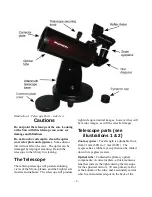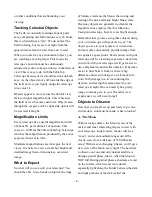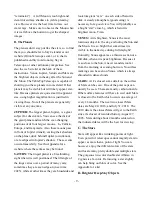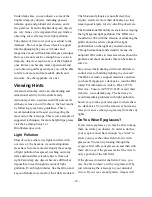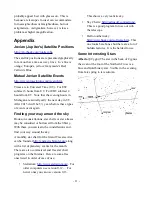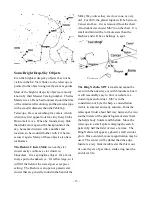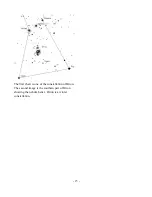
or other conditions that are hindering your
viewing.
Tracking Celestial Objects
The Earth is constantly rotating about its polar
axis, completing one full rotation every 24 hours;
this is what defines a “day”. We do not feel the
Earth rotating, but we see it at night from the
apparent movement of stars from east to west.
When you observe any astronomical object, you
are watching a moving target. This means the
telescope’s position must be continuously
adjusted over time to keep an object in the field of
view. This is easy to do with the TableTop
Telescope because of its smooth motions on both
axes. As the object moves off towards the edge of
the field of view, just lightly nudge the telescope
to re-center it.
Objects appear to move across the field of view
faster at higher magnifications. This is because
the field of view becomes narrower. Objects seen
through the eyepiece will be right side up but will
be reversed left-right.
Magnification Limits
Every telescope has a useful magnification limit
of about 2X per millimeter of aperture. This
comes to 180X for the 90mm TableTop Telescope
which is the magnification produced by the zoom
eyepiece when set to 7mm.
Moderate magnifications are what give the best
views. It is better to view a small, but bright and
detailed image than a dim, unclear, oversized
image.
What to Expect
So what will you see with your telescope? You
should be able to see bands on Jupiter, the rings
of Saturn, craters on the Moon, the waxing and
waning of Venus, and many bright binary stars.
Deep-sky objects are generally too faint at the
magnifications employed by this Maksutov-
Cassigrain telescope, but a few are bright enough.
Remember that you are seeing these objects using
your own telescope with your own eyes! The
object you see in your eyepiece is in real-time,
and not some conveniently provided image from
an expensive space probe. Each session with your
telescope will be a learning experience. Each time
you work with your telescope it will get easier to
use, and planetary and stellar objects will become
easier to find. Take it from us, there is big
difference between looking at a well-made full-
color NASA image in a lit room during the
daytime, and seeing that same object in your
telescope at night. One can merely be a pretty
image someone gave to you. The other is an
experience you will never forget!
Objects to Observe
Now that you are all set up and ready to go, one
critical deci- sion must be made: what to look at?
A. The Moon
With its rocky surface, the Moon is one of the
easiest and most interesting targets to view with
your telescope. Lunar craters, marias (dry lava
“seas”), and even mountain ranges can all be
clearly seen from a distance of 238,000 miles
away! With its ever-changing phases, you’ll get a
new view of the Moon every night. The best time
to observe our one and only natural satellite is
during a partial phase, that is, when the Moon is
NOT full. During partial phases, shadows are cast
on the surface, which reveal more detail,
especially right along the border between the dark
and light portions of the disk (called the
- 8 -
Содержание StarMax 90
Страница 16: ......


